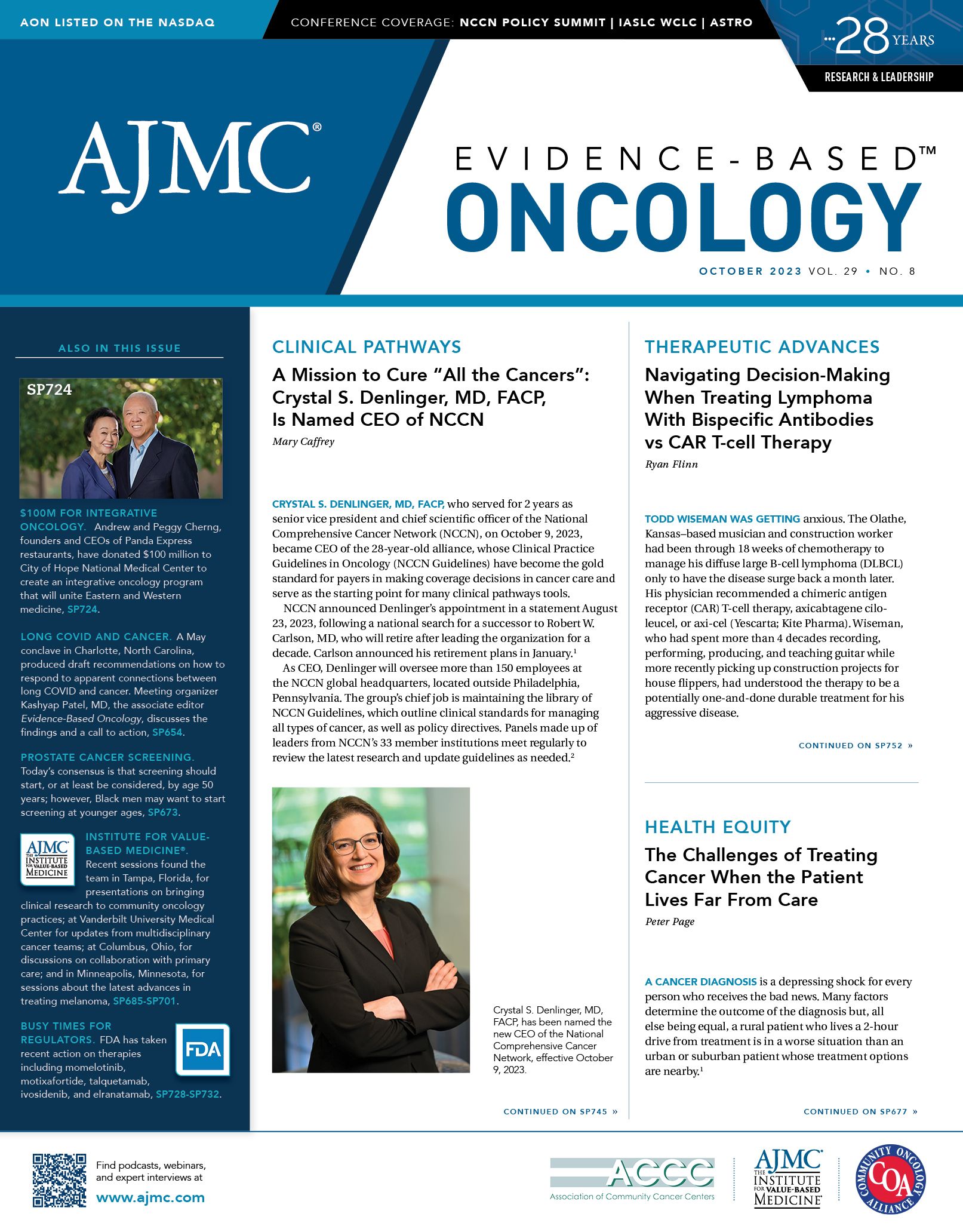- Center on Health Equity & Access
- Clinical
- Health Care Cost
- Health Care Delivery
- Insurance
- Policy
- Technology
- Value-Based Care
Perspectives on EOM: What Makes Sense Moving Forward
On July 1, 2023, CMS launched the Enhancing Oncology Model (EOM), the successor to the Oncology Care Model (OCM) for oncology practices seeking an alternative payment model (APM) specific to cancer care under the requirements of the 2015 Medicare Access and CHIP Reauthorization Act.1 That legislation requires Medicare practices to participate in an advanced APM or the Merit-Based Incentive Payment System (MIPS), which has a different set of quality, clinical improvement, and cost-reporting activities.2 As of July 1, a total of 44 practices had enrolled in the EOM, compared with 122 that remained in the OCM when it ended in June 2022.3
The US Oncology Network has 12 practices and the largest number of providers in the EOM. Even so, Lalan Wilfong, MD, senior vice president for Payer and Care Transformation at The US Oncology Network, said in an interview this summer that individual practice decisions came down to a review of practice readiness, analytics, and local market conditions.3
Evidence-Based Oncology (EBO) also spoke with Nathan H. Walcker, MBA, CEO of Florida Cancer Specialists & Research Institute (FCS), about the statewide practice’s decision following a review not to move forward with the EOM.
Excerpts from interviews were edited lightly for clarity.
References
1. What is MACRA? CMS.gov. Accessed September 21, 2023.
https://www.cms.gov/medicare/quality/value-based-programs/chip-reauthorization-act
2. Traditional MIPS overview. Quality Payment Program. CMS.gov. September 21, 2023. https://qpp.cms.gov/mips/traditional-mips
3. Caffrey M. Final EOM list favors larger practices; AON strategy helps smaller groups. Am J Manag Care. 2023;29(Spec 7):SP633-SP635. doi:10.37765/ajmc.2023.89421
findhelp. Accessed September 21, 2023. https://www.findhelp.org/
SPOTLIGHT: Lalan Wilfong, MD, senior vice president, Payer and Care Transformation, The US Oncology Network
EBO: What are some ways that The US Oncology Network will support practices and physicians that have decided to participate in the EOM?
Wilfong: The things that we’re helping them with include [providing] analytic tools so they will be able to manage the program on a proactive basis [in] risk stratification of patients. This includes helping them with the basics, [such as ensuring] they are getting [a screening for] social determinants of health.
We have implemented systems where practices can connect patients who have needs with resources through a national partnership with the social care network findhelp.4 We have regular educational meetings about the EOM in which we share best practices; we were going to do them monthly, but everybody wanted every other week—so we’re going to do them every other week. [At these meetings] we educate everyone on a topic, talk about best practices, look at gaps in our network, and work to fill in those gaps. We are beefing up our digital health strategy quite a bit to help with this.
We’re really doubling down on our drug utilization strategy. As you know, 70% of the cost of care in the EOM, in our estimation, is drug costs. We need to have a proactive drug strategy for how we manage those costs. And we’ve been doing that for a long time at US Oncology. We’re working even harder to make sure that we have appropriate drug selections for patients to help make sure we’re managing the total cost of care.
SPOTIGHT: Nathan H. Walcker, MBA, CEO, Florida Cancer Specialists & Research Institute.
EBO: What were the chief considerations in evaluating the decision whether to take part in the EOM at Florida Cancer Specialists & Research Institute?
Walcker: At FCS, we looked not only at the EOM in a vacuum, but how it fits into our broader holistic care model—and ultimately, what we’re trying to achieve from a value-based care perspective. What it comes down to is, how do we best serve all of our patients in our markets every single day to get the right therapeutic decision, the right level of value upstream to the payer and also to the patients? How you do that is you make sure you have a comprehensive model with metrics that are scalable, that are repeatable, that are accurate. And that’s been a big, big challenge as we’ve looked at many of these different models….
Ultimately, it’s so many different variations of different things.
What we’re trying to do is focus on making sure we have repeatable wins in these metrics and these quality scorecards and that the VBC (value-based care) platform serves all patients. I think one of the challenges, particularly when you look at the new EOM, is, with the [limited number of] cancers that are included in that model, it would have severely impacted the number of physicians who would be seeing patients within the EOM and ultimately served from a VBC perspective. That’s why we’re really excited about doubling down on our MIPS program to continue to serve patients—all patients who are on Medicare—and also continue to [increase] our ability to engage with our commercial partners in the same way.

Dr Lucio Gordan Discusses Updated Guidelines Addressing 1q Abnormalities in Multiple Myeloma
October 27th 2023Lucio Gordan, MD, president and managing physician of Florida Cancer Specialists & Research Institute, discusses recently updated clinical guidelines from the National Comprehensive Cancer Network (NCCN) in multiple myeloma, which specifically discuss disease staging and risk stratification and advise clinicians on how to address 1q abnormalities.
Listen
Nathan Walcker Discusses Value-Based Oncology Care Initiatives at FCS
September 8th 2023Nathan Walcker, CEO at Florida Cancer Specialists & Research Institute (FCS), highlights some of the recent partnerships and initiatives at FCS to improve community-based oncology care from a value-based perspective.
Listen
